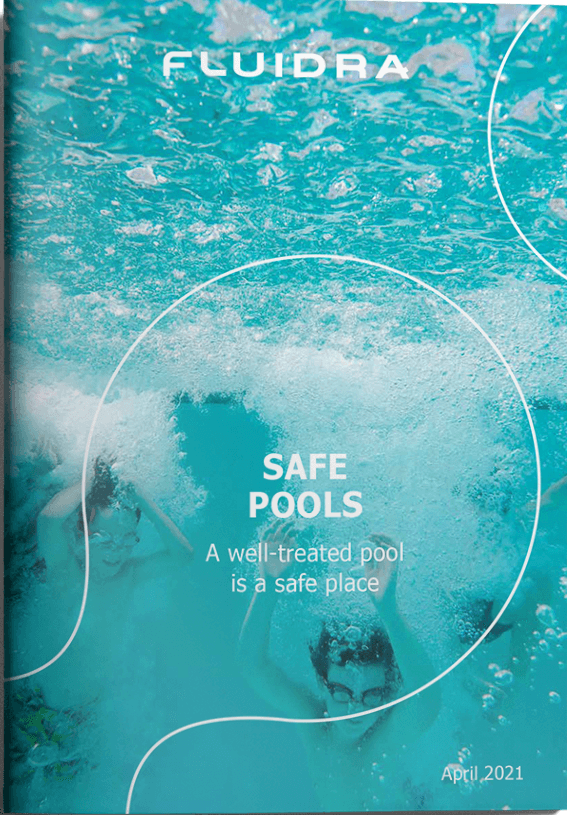
A pool is an essential facility at any high-end hotel or sports club. This is why these exclusive facilities need to always be in a perfect state of repair, with clean, attractive surroundings and sides, and crucially, excellent water quality. Any oversight in water control or maintenance can lead to green water – an obviously unprofitable situation for pool operators.
This occurs due to the presence of microorganisms forming algae. These organisms are deposited through wind and rain, and they reproduce rapidly. Another cause is the metal content of rainwater, which causes an imbalance in the pool’s pH levels, resulting in an unpleasant green pool.
We will discuss the following subjects: how to remove the algae if you already have a green pool; how to take preventative measures, including chemical and natural methods; and which is the most sustainable approach to keep the pool water blue and clear: the Freepool2 system.
If you already have a green pool, the first step is to checkup the pH level ––if it is too high (above 7.6), no treatment will work properly. Then, whether the pool is treated with chlorine tablets, you need to make sure the cyanuric acid concentration isn’t above 50ppm. If this is the case, the only solution is to partially empty the pool to reduce the concentration.
If the pH and cyanuric acid levels are acceptable, you can filter the water to remove the algae. Filtration will take 24-48 hours, with incremental checks that the filter isn’t blocked. As soon as the sides and bottom of the pool are visible, you can brush the algae-covered areas.
If this doesn’t work, the next port of call is shock treatment. This involves pouring a greater amount of chlorine or disinfectant into the pool. The amount will depend on the manufacturer’s advice. You could also use a flocculant to improve the performance of the sand filter. After this process, a longer backwash is recommended.
The best way to prevent algae growth is to perform a weekly pool cleaning and maintenance. This routine includes tests for controlling the parameters that allow algae to thrive:
- Ensuring the water pH is between 7 and 7.6, the ideal level being between 7.2 and 7.4.
- Use an appropriate dose of disinfectants, and remember: too high a dose is just as harmful as too low.
- If the disinfectant you use is not an algaecide, perform an additional anti-algae treatment two or three times a month. This can be repeated more often in warm pools.
- Checkup the phosphate levels, which are the favourite food of algae. Depending on the pool’s location, the water may be naturally rich in phosphates. In this case, you should use a special anti-phosphate product.
For the daily maintenance of communal swimming pools, cleaning the bottoms and walls of small-and medium-sized pools up to 25 meters, Zodiac® VORTRAXTM series of electric cleaning robots are an ideal solution. Using powerful cyclonic suction, they efficiently suck up all types of debris.
So far we have talked a lot about disinfectants and algaecides, but what if the pool operator wants to use a natural method? A high-functioning salt chlorinator generates natural chlorine via electrolysis, which converts salt into gaseous chlorine and sodium. As with chemical chlorine, natural chlorine is a powerful oxidizing disinfectant that eliminates microorganisms (bacteria, algae, etc.) very effectively.
The pool water is slightly salty (between three and five grams of salt per litre, which is nine times less than seawater). The main advantage of saline electrolysis is that it provides a natural treatment that is much more environmentally respectful and more pleasant to swim in.
Furthermore, the treatment is cyclical. That is the chlorine turns back into salt when exposed to UV rays. These systems are easy to install, suitable for renovations and compatible with all types of coatings.
You can also go one step further with Freepool2: a swimming pool treatment solution based on electrolysis and ultraviolet technology. It offers the main advantages of both these methods without their drawbacks or limitations:
- Provides effective double disinfection (electrolysis + UV).
- Greater capacity for chloramine removal without the need to clean the filter.
- Enhances sustainability by saving water and energy.
- Eliminates the necessity to add salt to the pool glass.
By removing chlorine, it is not necessary to store or manipulate any type of chemical product, making pool maintenance safer, easier and more sustainable.
In addition, Fluidra Connect smart solution can regulate the water supply, temperature and communicate with the rest of the water treatment equipment, and measure pool pH levels via CO2 injection – all through the software and control screen.
